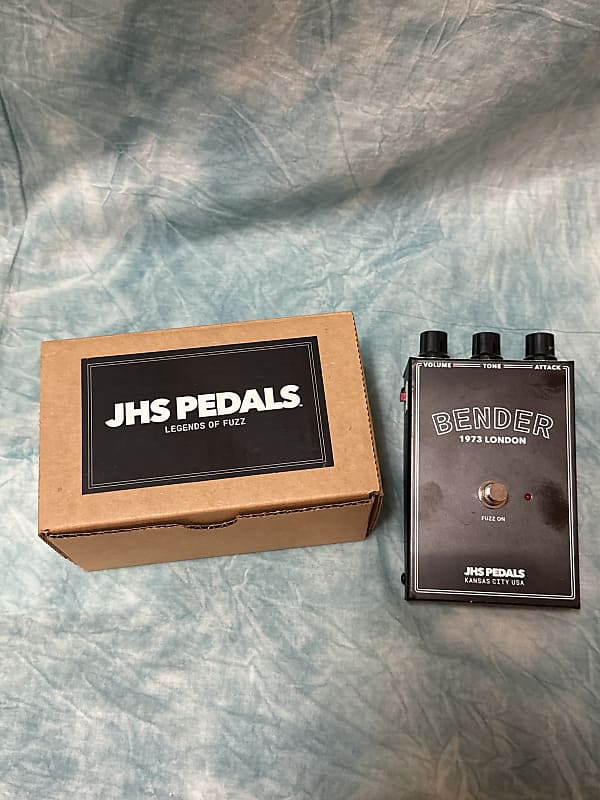Recreation of the 1973 MK.III TONEBENDER
https://www.jhspedals.info/fuzz-series-bender
Go to the Module Detail PageIf you had an Unicorn Account you could see a chart with the price development of this module and the average price asked for this module.
The "Legends Of Fuzz'' series is a collection of the world's most historic, rare, and sought after circuits. At JHS, fuzz pedals have been in our lineup for over a decade. We have designed original circuits, replicated classics, and we have seen the trend of fuzz popularity come and go. The "Legends Of Fuzz'' series is our tribute to the most important fuzz circuits ever made. It is our way of ensuring that the stories of these effects live on in the music that you are going to make. From the earliest days of fuzz in the mid-60's London scene to the 1990's ex-Soviet military factories that brought the Big Muff back to life, fuzz tells a story, and that story includes guitarists just like you. There is nothing more primitive than plugging your guitar into a vintage fuzz circuit; it is raw, untamed, and so pure that it pushes the boundaries of what your instrument can accomplish. Plug into a fuzz and plug into sixty years of beautifully broken sound. In April of 1965, a new device changed rock 'n' roll forever. From the back workbench of Macari’s Musical Exchange on Denmark Street in London, Gary Hurst invented the Sola Sound* Tonebender* fuzz. Building on the foundation of the American-made 1962 Maestro Fuzz Tone*, Gary expanded what fuzz could do and gave a new sound to the thriving London music scene. Starting with his very first prototype made in a simple wooden box (April 1965) to the many other official Sola Sound* versions like the MKI (Sept 1965), MK2 (Mid 1966), MK3/MK4 (Feb 1970), etc., the Tonebender* has evolved just like the music that it helped create.The JHS Bender is our attempt to recreate the most prized Tonebender* in my collection: my 1973 MK3 Silver/Orange “Onomatopoeia” version. This version has three very special germanium transistors, tons of mojo, and fifty plus years of experience, but it is finicky and it doesn’t always do what you want it to do. I had to ask: could we replicate this pedal sonically? Could we capture what it's all about, but in a way that is more consistent, dependable, and easy to manufacture? Yes. The end result is a pedal that gives you the touch, feel, and response of the vintage germanium fuzz but with accuracy and consistency of carefully chosen modern silicon transistors. The controls are Volume, Tone, and Attack. Volume sets the overall output level of the effect; turn it up and things get louder. Tone lets you sweep between bright and dark tones so that the Bender works well with a range of different amplifiers and guitars. Attack is the distortion control, the more you turn it clockwise, the more fuzz you create. On the side you will see a “Mode” button that lets you access a never-before-heard “JHS Mode”. Push that button for more gain and a mid frequency boost to send your leads soaring through the mix. With higher Attack settings in this mode, you will feel the fuzz slightly gate depending on your picking dynamics. If you want a fuzz that can go from middle of the road crunch distortion to full out aggression, the Bender is for you. The tone control is extremely flexible and allows for dozens of sonic variations that most fuzz users only dream about. If you love the fuzz sounds of Led Zeppelin, Jeff Beck, The Beatles, Mick Ronson (David Bowie), and My Bloody Valentine, then the Bender is for you.

This offer was fetched from reverb.com. You cannot contact the seller via ModularGrid. You have to visit their site.
Look up onDisclaimer: Modules listed for sale on the ModularGrid Marketplace are offered explicitly by their respective owners. ModularGrid is not affiliated to the sellers and takes no legal responsibility in any transaction.
The internet is a rough place and fraudulent behavior can occur. If you are concerned about dealing with strangers consider buying your module at an authorized dealer.